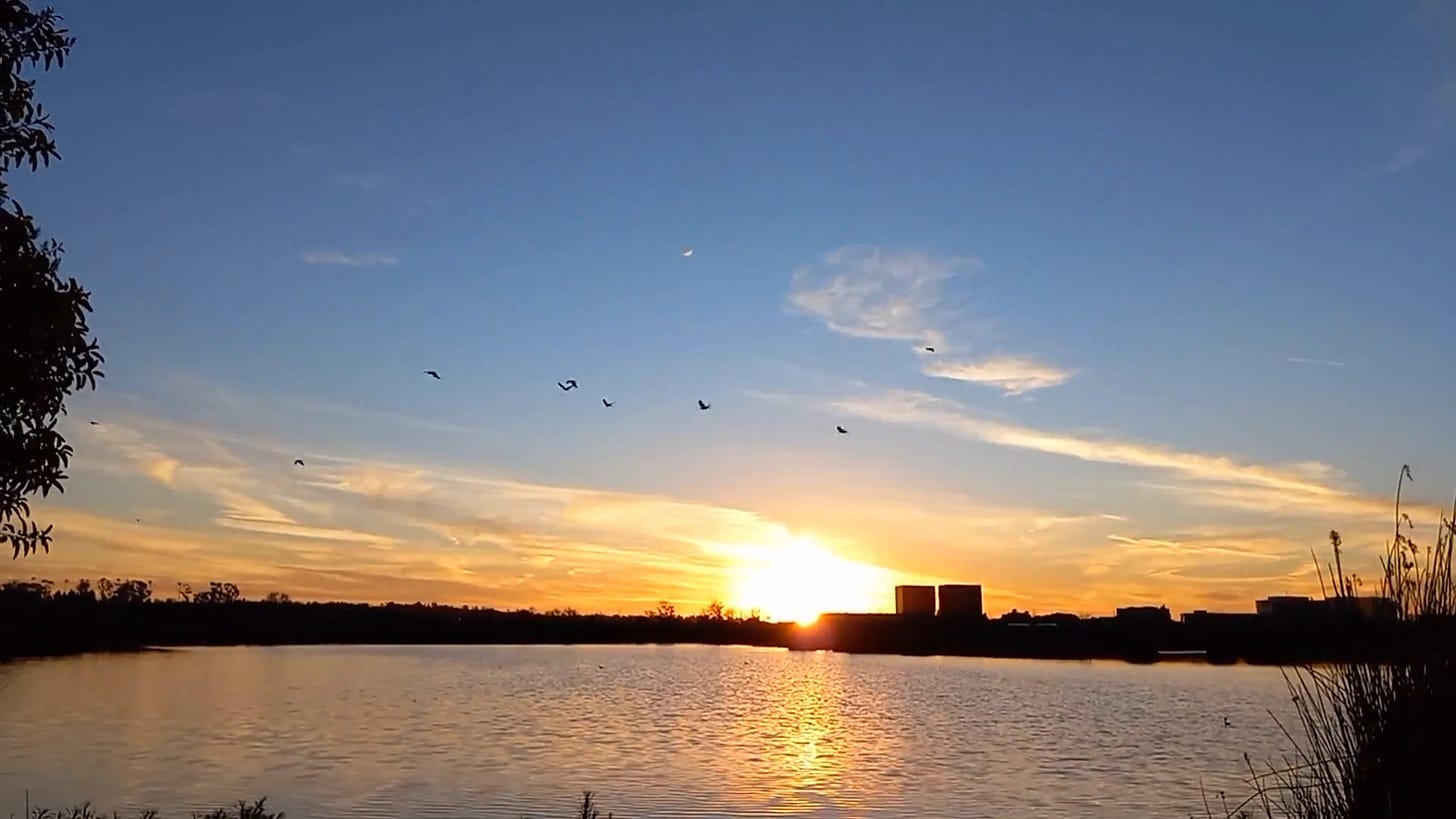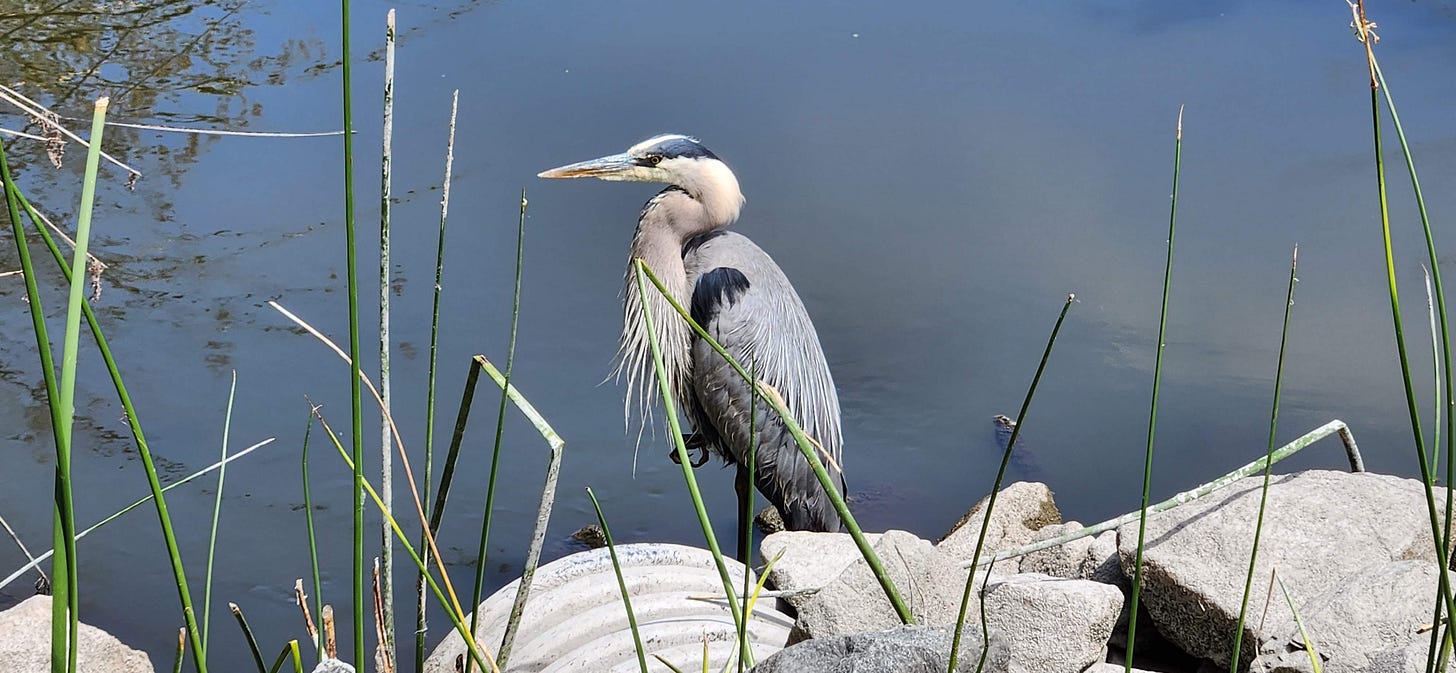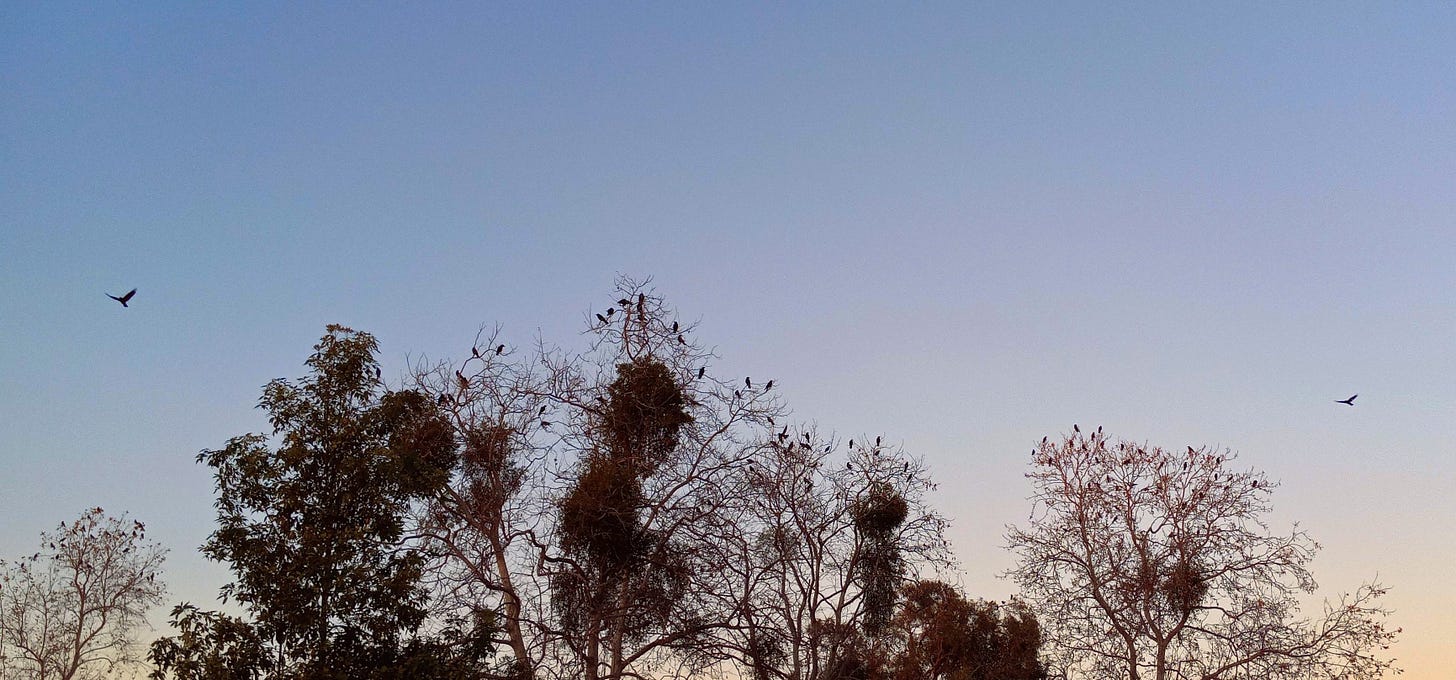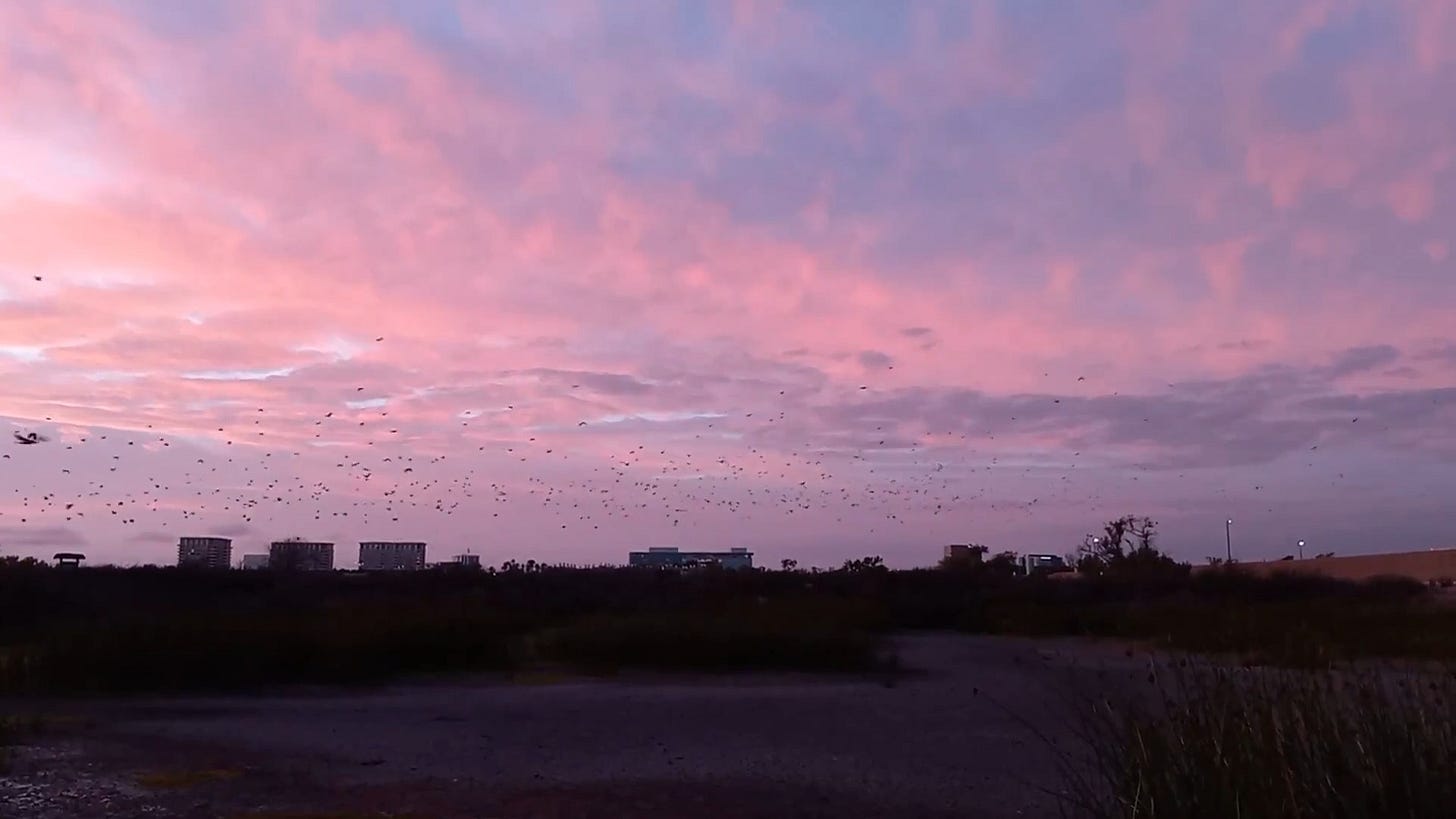It’s one of my last evenings in California before we move to New Jersey for a year. So of course I’m spending it trying to say goodbye to a bunch of birds.
I have a unique relationship with the animal kingdom. As my younger son has noted, most of my stories about animal encounters end with the words, “It was terrifying.”
He’s right. The Foghorn Leghorn-sized rooster I encountered in Provence? Terrifying. That time I slid down a muddy hill ahead of a herd of cattle eager to get to the barn for dinner? Yep, terrifying. The crazed seagull that snatched my sandwich in Helsinki? Do NOT get me started. My track record with animals you wouldn’t pet isn’t exactly stellar.
But there’s a thin line between terrifying and fascinating – a little something I learned from the crows at the San Joaquin Marsh and Wildlife Sanctuary in Irvine, California.
San Joaquin is where I fell in love with California’s birds. The sanctuary’s ponds are giant filters, where aquatic plants and microbes cleanse Irvine’s urban runoff before it flows into Upper Newport Bay. (“Urban runoff,” by the way, is any water that flows into storm drains when there are no storms. In sunny California, pretty much all water that flows into storm drains qualifies.)
But San Joaquin’s ponds are more than just filters. They’re also bird magnets, attracting Herons, Egrets, White Pelicans, Caspian Terns, Black-necked Stilts, and Common Yellowthroats, among many, many others.
There’s nothing like an early morning walk among the ponds. Except, perhaps, a sunset walk among the ponds. Because sunset is when Every Single Crow in Orange County comes to San Joaquin to roost at the end of a long day.
The Crows of San Joaquin are tremendously smart. They understand how much fun it is to sneak up on unsuspecting newbies making their first late afternoon visit (not that I speak from experience). They don’t arrive all at once. They come solo. They come with a few friends. They come in groups just small enough that you pay them no heed. But the tipping point comes, and when it does, it comes fast. A few crows become a few dozen. A few dozen become a few hundred. And a few hundred become many hundreds. By the time you realize you’re on the brink of a “situation,” it’s too late.
At this point, if the crows were fruit, you’d be awestruck by the abundance of nature in the trees. But crows aren’t fruit, which means this particular abundance will likely elicit a different response. If you’re the David Attenborough type, you might say something like, “My, what an astonishing number of crows.” Or, if you’re more cinematically inclined, “Surely, this is what inspired Hitchcock.” Or, if you’re me, “This is terrifying!” You can say all these things if you want, but no one will hear you, because you are standing before thousands of crows, all of them caw-ing away as they share the news of their day with their best crow friends.
I can assure you from experience you’ll survive the gauntlet. (And, because I can practically hear you asking as I type this – yes, I made it through bird-poop-free. We’ll not speak of this again. But you might want to bring an (old) umbrella.) You’ll survive, but not soon forget, the Crows of San Joaquin. Their numerosity is indelible. And fascinating. And terrifying.
During my time in California, I’ve come to deeply admire the intelligence of crows. They recognize faces, and they remember who’s been nice to them – and who hasn’t. I’ve taken to offering a friendly “hello” to any crows I encounter on my walks. (Just one of many ways I embarrass certain offspring, but better safe than sorry.) I have zero doubt the crows are passing messages down the line as I walk by. Hopefully, good ones.
Did you know crows can count to four? There’s no documentation they can count to five (yet), but when it does, I just know it’ll happen at San Joaquin. One evening, just after sunset, the Crows of San Joaquin will be draped along the tree branches, flapping their beaks, when one restless Corvid – we’ll call him Chuck – will start counting his fellow crows.
“One, two, three, four….” When he gets to the next crow, Chuck will start over, because “four” is the limit of what he knows. Over and over, Chuck will count crows, four at a time. But as he counts, something inside Chuck will whisper with growing urgency, until he can’t take it anymore.
“Excuse me,” Chuck will say, “anycrow know what comes after four?”
Like a stadium doing The Wave in reverse, a hush will roll across the crow-filled branches, until the only sound is the cackling of the Caspian Terns from two ponds over. The Terns don’t speak Crow, they’re too busy skimming the pond for water bugs, and frankly, Terns aren’t into numbers.
From three trees away, another crow – I just know his name will be Larry – will have been pondering Chuck’s question.
“Hey, Chuck?” Larry will caw.
“Hey, Larry,” Chuck will respond. “How’re they flappin’?”
“Try seven,” Larry will offer.
Seven? A murmur of approval will rumble through the treetops, signaling consensus. (I said crows were smart. I didn’t say they were perfect.) And Chuck, satisfied, will return to his counting.
“One, two, three, four…seven!” Chuck will smile, which isn’t exactly easy with a beak. “Man,” he’ll say, “that Larry’s one smart cookie!”
A thousand crow heads will turn toward Larry. Did someone say “cookie?”
And a flurry of wings will ensue.
Clearly, I’ve got a thing for these crows. Which brings me to this final sunset visit to San Joaquin. This time, though, I’ll be watching the spectacle from the safety of the pond closest to the parking lot. And I’m bringing the husband for backup.
But the Crows of San Joaquin are smart, remember? The husband and I wait. We wait some more. We walk out among the ponds because (1) we’re restless, and (2) what could tempt the crows more than a chance to make us run their gauntlet one last time?
As it turns out, what tempts the crows more is having the last laugh. By 7:30, they still haven’t shown up. It’s August – maybe it’s like Paris and they’ve all left town, I say. Speaking of Paris, my husband replies, isn’t tonight the closing ceremonies of the Olympics? His idea of spectacle differs somewhat from mine.
The Olympics win out, and I give up. And, of course, as we drive home on the 405, I watch the Crows of San Joaquin fly overhead, in twos and threes, heading home to roost. You might think I’m upset that they stood me up, but I’m not. They’ve given me a goodbye gift – a reason to return.
In my three years in California, I learned much from the Crows of San Joaquin. The wonder of everyday things. The joy of watching birds. That if you’re looking for a decent accountant, don’t hire a crow named Larry.
If you ever find yourself in Irvine around sunset, pay the crows a visit. You’ll be glad you did. It’s amazing. And terrifying.










Another good one. Just keep writing. My oldest daughter has a wonderful talent that should be widely shared.
Just think they almost didn't make it! Back in the mid/ late 90s, a big bird flu or something wiped out almost all the crows in orange county, maybe even southern CA. I remember bawling! I also remember prior to the "extinction" event, the SIZE of them! I sware I seen several giant crows that stood at least 2.5' tall and were so girthy, they waddled instead of walked and all other crows would chant for the big one when there was possible trouble on the ground and when he arrived, all the others, still rhythmically crowing, would separate creating a zipper like lane for crow daddy to waddle through and up to whatever "danger" so worried them all(usually just me and a friend rolling up during 1st period and sitting in a car). Biggie would then turn his head sideways to examine us for a minute and then usually he'd walk away or wait for food. Anyways... after the bird flu really started wiping them out, the big ones went first sadly. I still haven't seen the giant sizes as 25-30 years ago BUT I've noticed they're getting closer... I think like over 90% of them perished while the ones who survived would go on to pass their IMMUNITIES onto the next generations , until now.
Also, crows act as parking lot cleaners by eating all the wasted fast food people just throw in the street and lots. They're getting smarter. I have several that go back and forth from my house to my friends a couple blocks over. I used t0 feed one snail's and he/ she ended up bringing 2 others and then the entire family. They'd bring me little trinkets as gifts. Little shiny baubles and scraps of discarded things. I have a bird bath and so many different birds stop by. Also there's a female hummingbird that's gotta be AT LEAST 13 years old. She's a little terror who lives in the ancient avocado tree behind my house. Funny thing is she waits for the sugar water feeder to condense and "liquor up" before she partakes, then she defends it with a callous ruthlessness that makes tasmanian devil's seem tame. One rainy day I watched her bathe under a tiny leaf waterfall. She rolled around on a hibiscus leaf while the leaf above acted as a waterfall pouring water down. It was the coolest thing... next to watching her and her bf sky dance. One morning as she was perched on the highest leafless peach tree branch, her "man" came zooming speed of light fast right into her but at that moment, she lifted in flight and pressing into the Male as he pressed back, twirled super fast around each other straight up about 20 feet. Picture a spinning barber's pole but super fast and much taller. It happened so fast I couldn't believe it. They're in love for sure. She's already birthed multiple little hummies from him. He doesn't migrate south like the others and he's the only one allowed to drink from HER nectar spots. Her family and ancestors have been living in that tree for before I was born and im already 46.
We used to have mourning doves make nest and give birth but I haven't seen any for several years. Black phoebe's make mud nests on the highest area's of my house but one day I accidentally blasted the nest with a hose and scared the poor thing away. That was 2 years ago and she's only recently started coming back. The hawks love them.